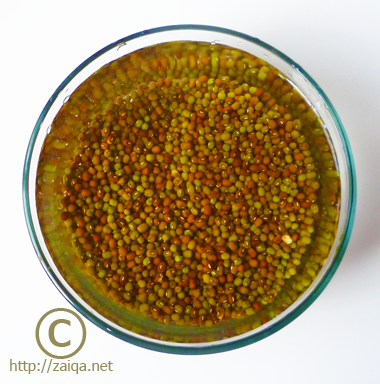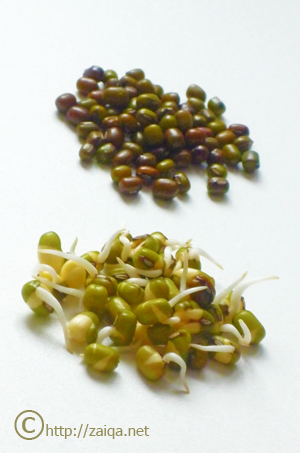Sprouting Moong
Sprouting whole green gram or Sabut Moong/Hari Moong is quite simple. Here is a simple tutorial showing the procedure. Moong is the most widely sprouted pulses in the world.
Day 1-Night: Wash and soak a cup of whole Moong dal in surplus fresh cool or tepid water in a dark place.

Sabut Moong/Whole Green Gram Soaking in water
Day 2-Morning: Drain the dal and shower wash them gently under cool or tepid water. Soak them again the same way.
Day 2-Night: Before you go to sleep, line a colander with wet muslin cloth and drain the plumped up dal. Tie the ends of the cloth into a knot. Hang in a dark place at room temperature where it wont be disturbed.
Day 3-Morning: Check the dal if they have started sprouting. The dal should have sprouted usually by this time if you happen to live in warmer areas.

Sabut Moong~Whole Green gram (behind),
and Spouted Sabut Moong~Green gram (front)
If it hasnt, which happens if you are living in colder areas, use a sprinkler to spray some fresh cool water on the cloth if its dry.
Day 4-Night: Your sprouted moong is ready. If they have not much sprouted, leave them for the night and enjoy these sprouted Moong.
Note:
1. Do not let the sprout shoots grow too long. It is suggested that they shouldn’t be longer than double the size of seed itself.
2. To store the sprouts, put them in a glass bowl and submerge them in cold water. Refrigerate it and they stay crisp for almost 5 days. I had read about this tip in a magazine which I thought to share.
Sprouted Moong are a good source of proteins, vitamin-C, iron and potassium. They are best eaten raw in salads, or very lightly cooked. Long cooking methods destroys the vital vitamins and disrupts the flavor. I usually prepare a light snack using sprouts. You can also add sprouts to pasta and noodles, or salads for some extra nutrition. I also like to use the sprouted moong as a stuffing in the wraps and fajitas along with the other ingredients and also in the Fried rice.

Picture Source: Flickr
I leave you with the snapshot of a Velvet Mite which we call ‘Birbabuti’ in Urdu. We witness a lot of them just after the first rains in Hyderabad. These harmless mites are so tiny and very restless arthropods. Their sensory velvety red covering is gorgeous. Children were always very attracted to them. Are you guys familiar with it?
Luv,
Mona
You can follow any responses to this entry through the RSS 2.0 feed. You can leave a response, or trackback from your own site.
March 29th, 2009 at 11:43 pm
Thats very healthy and useful Mona! Second pic is awesome! 🙂
Btw, haven’t seen those mites…
March 30th, 2009 at 2:37 am
that might is strangely, handsome? A very interesting looking creature. It’s no wonder why children would find them fascinating.
March 30th, 2009 at 4:17 am
Hi Mona,
that was a neat explanation for sprouting moong.lovely pics:)
hadn’t heard of the velvet mite…looks cute and creepy too 😉 thanks for the info.
TC
March 30th, 2009 at 5:54 am
Thanks for the tutorial, Mona. It somehow reminded me of our highschool project 🙂
Your pictures always turn out so beautiful!
I’ve never seen those mites either, but the red color is very pretty 🙂
March 30th, 2009 at 11:16 am
monaji, thank you very much for such wonderfull tutorial for sprouting mung. nice picture. may i ask you is it same prodecure for other beans also?! like moth, chana, peas etc.
Follow the same procedure for sprouting moth, chana etc.
March 30th, 2009 at 2:13 pm
I have heard of BIRBUHITI. My mom and my motherinlaw are from Hyderabad Deccan that is why. I like your recepies.
March 30th, 2009 at 2:13 pm
Nice post… the mite is really interesting 🙂
March 30th, 2009 at 5:25 pm
Hi Mona,
I remembet that mite. When I was a child I used to play with it. We used to search for those in the grass and collect them into those big match boxes and play with them( I know that’s wrong but then I didnt know better then). It used to become like a ball when we touched it.
Ranjitha
March 30th, 2009 at 10:53 pm
hi mona cud u pl post some recipes which uses theses sprouted moong as a sidedish or gravy ?
thankx in advance
regards
sas
March 31st, 2009 at 1:46 am
I love sprouting, thanks for sharing this Mona!
March 31st, 2009 at 12:50 pm
hi mona, i used to keep these tiny ones in a match box , take it to school also….do they still exist? its been 20 yrs i never find any…..
They still do exist and children still love them~Mona
March 31st, 2009 at 3:02 pm
Mona, great post! my hubby has been making mung sprouts for weeks now he is having a sprout fad. Have you tried alfalfa sprouts? they are my favourite as they grow really thin and are crunchy.
Is Urdu your first language Mona? I used to learn to speak read and write Urdu but I have not had time the past year. I wish I could learn Urdu more as I love it as a language.
Yes, my first language is Urdu. It is beautiful language.
March 31st, 2009 at 4:01 pm
Lovely pics Mona. I love sprouts….nice tutorial 🙂
March 31st, 2009 at 5:49 pm
Nice pics.. Love sprouts in yogurt..
April 1st, 2009 at 1:13 am
Gawrsh! Birbabutis how can you not love them. I used to always have some as my pets. LOL 😀
April 1st, 2009 at 10:05 am
My mom’s absolute favorite,moong sprouts were our snacks very often.Birbabuti sure reminds me of my innocent childhood:)
April 2nd, 2009 at 9:08 am
Lovely double shaded Moong, sprouted Moong makes everything so healthy and tasty! 🙂
Never saw those critters before, velvety indeed! 😀
April 15th, 2009 at 1:48 pm
thanks for the picture…i have been trying to tell my husband and kids about this mite we caught in match boxes and he had never heard about it !! Now i can tell them its true !! Have not seen one in India in years….
Thanks
April 21st, 2009 at 4:20 am
Sounds so yummy .. I’m gonna definitely try this one :>
ps: the velvety creepy is so cute .. never seen ’em in Pakistan =)
April 21st, 2009 at 5:25 pm
Hi, I’m from Hyd too and was talking about the “red velvet boochi” we used to collect in match boxes, when I saw your post – now I can call it by its name – birbabuti!
Appreciate all the recipes – they’re great!!!
October 7th, 2009 at 11:45 am
healthy moong sprouts..cud u post some recipe for this? anyways, u say that the sprouts shud not grow too long. why is that?
Sri, I will post some recipes using sprouted moong in the future. If you allow the sprouts to grow longer, they develop bitterness that is not suitable for consumption. See that the sprouts are no longer than the seed itself. ~Mona
May 24th, 2011 at 11:06 pm
Ofcourse i know the Birbaaboti’s….use to collect them and keep them in small match boxes w/green grass…but they didn’t like that….cos they didn’t live too long that way….:-))….and thanks for the moong sprout recipe…cant wait to try it.